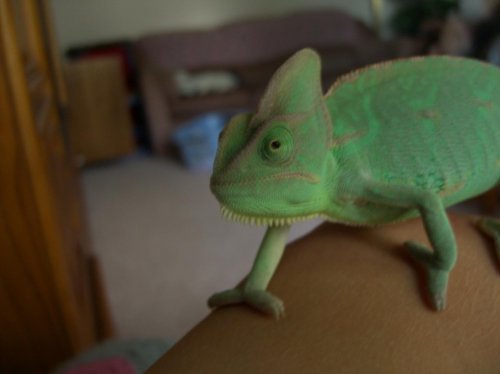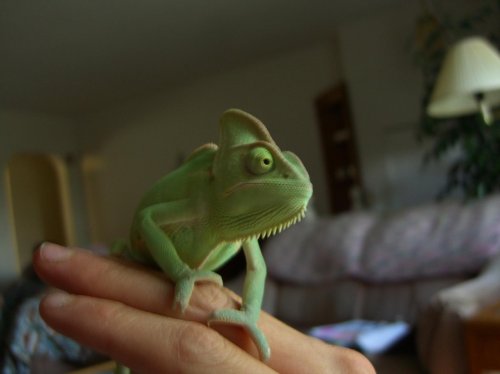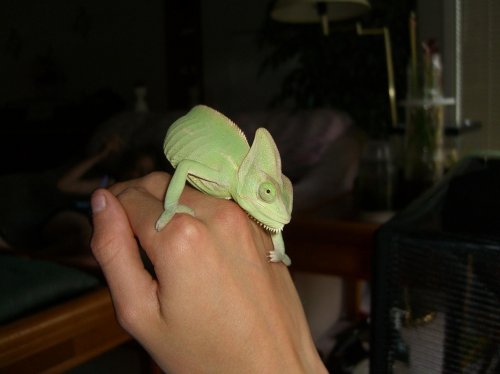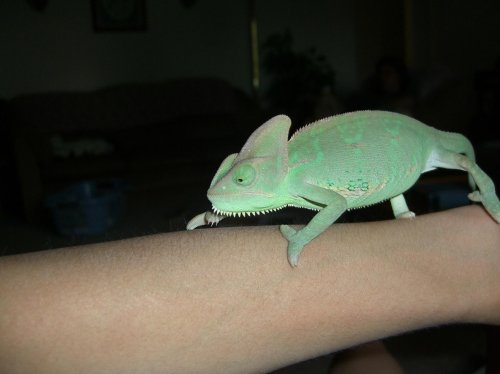Navigation
Install the app
How to install the app on iOS
Follow along with the video below to see how to install our site as a web app on your home screen.
Note: This feature may not be available in some browsers.
More options
You are using an out of date browser. It may not display this or other websites correctly.
You should upgrade or use an alternative browser.
You should upgrade or use an alternative browser.
When will they stop growing?
- Thread starter Jevin
- Start date
Brad Ramsey
Retired Moderator
They actually never stop growing.
The speed at which they develop in the first year is largely effected by how much food they are getting.
How much are you feeding her?
How many months old is she?
-Brad
The speed at which they develop in the first year is largely effected by how much food they are getting.
How much are you feeding her?
How many months old is she?
-Brad
jannb
Chameleon Enthusiast
At about 5 to 6 months old start feeding her everyother day and keep her temps in the low 80's unless you are planning to breed. Here's a great bolg on raising a female veiled:http://raisingkittytheveiledchameleon.blogspot.com/2007/12/keeping-female-veiled.html
BTW: She's a real cutie!!!!!
BTW: She's a real cutie!!!!!
Jevin
Chameleon Enthusiast
I feed every day otherwise she becomes cranky and hides away in her cage and her basking area in ner large cage will only breach 90 degrees when the sun is shining. I really dont like seeing her cranky because she flash her markings jet black and she never refuses food. I wouldn't kmnow for sure if she'd get cranky but if im late for feeding her she'll get cranky so I'd hate to see her if I "missed" a regular feeding
I wouldn't kmnow for sure if she'd get cranky but if im late for feeding her she'll get cranky so I'd hate to see her if I "missed" a regular feeding
Brad Ramsey
Retired Moderator
I feed every day otherwise she becomes cranky and hides away in her cage and her basking area in ner large cage will only breach 90 degrees when the sun is shining. I really dont like seeing her cranky because she flash her markings jet black and she never refuses food.I wouldn't kmnow for sure if she'd get cranky but if im late for feeding her she'll get cranky so I'd hate to see her if I "missed" a regular feeding
Well, you need to start or you're going to have a female that doesn't live very long and cycles eggs way too often.
5 to 7 crickets every other day.
-Brad
jojackson
New Member
Lol Jevin, are you thinking 'veiled-Zilla'?  reptiles growth continues throughout life but slows considerably after maturation. As someone else mentioned, growth in the first year of life is much accellerated, by this time most reptiles acheive adult size or close to (lizards anyway).
reptiles growth continues throughout life but slows considerably after maturation. As someone else mentioned, growth in the first year of life is much accellerated, by this time most reptiles acheive adult size or close to (lizards anyway).
Veiled chams do have a phenomonly fast rate of growth as compared to other lizard species, and ofcourse, like any other species, this is largely dependant on available food.
Its well pointed out that with either sex a balance should be acheived lest growth overtake skeletal developement.
With females in particular, care should be taken with dietry intake, since the more avail food, the more the animal will eat and in turn, the larger the production of clutches, which will effectively shorten the life of your female.
Veiled chams do have a phenomonly fast rate of growth as compared to other lizard species, and ofcourse, like any other species, this is largely dependant on available food.
Its well pointed out that with either sex a balance should be acheived lest growth overtake skeletal developement.
With females in particular, care should be taken with dietry intake, since the more avail food, the more the animal will eat and in turn, the larger the production of clutches, which will effectively shorten the life of your female.
Jevin
Chameleon Enthusiast
I see but the size of crickets she is fed are about 1/4-3/8ths of an inch and she only gets about 10 of those a day. the ones that are left over we put back into the main cricket container. the cricketrs though aren't even truely "gut loaded" because I do not have sufficent funds at this time.
jojackson
New Member
I dont think anyone can accurately say your cham is too heavy, or vice versa unless you can weigh it, roughly measure it (nose to cloaca) and post up. BUT..
It wont hurt your animal to go without food here and there a day, even if it seems to sulk. Reptiles are designed for low food intake, maximum energy extraction, since they get most of their energy from the sun. Only coddled captive reptiles eat every day.
It wont hurt your animal to go without food here and there a day, even if it seems to sulk. Reptiles are designed for low food intake, maximum energy extraction, since they get most of their energy from the sun. Only coddled captive reptiles eat every day.
Jevin
Chameleon Enthusiast
she is five inches from her nose to the base of her tail and not at all fat looking if you look at the photos I posted earlier. If possible could you post a pic of an overweight veiled chamemleon. and just a little extra info is that she rarely ever stops moving when in her cage yet when being held she'll hardly move at all.
jojackson
New Member
Then shes certainly big enough not to be bothered by missing a feed every other day or so. According to the Female owners here, its a good idea to include a deep tub of soil for her now (leave in the cage like furniture) because she is approaching maturity and will at some point develope a clutch of eggs.
Brad Ramsey
Retired Moderator
It's not about being "fat"
It's about creating conditions that are too good all the time and tricking their bodies into cycling eggs three or four times a year when in their natural environment it happens once a year or not at all.
Better figure out the gut load too and are you dusting with calcium?
-Brad
It's about creating conditions that are too good all the time and tricking their bodies into cycling eggs three or four times a year when in their natural environment it happens once a year or not at all.
Better figure out the gut load too and are you dusting with calcium?
-Brad
Miss Lily
Chameleon Enthusiast
I learnt the hard way with feeding a female too much - she was my first chamm, and, at the time I didn't know better! I got Lily at 6 months of age and she would eat a lot of food. She laid her first infertile clutch of 104 eggs at 14 months old and her second clutch of 102 infertiles at 18 months old. I learnt that you have to 'be cruel to be kind' and that chams aren't like 'normal' pets when it comes to feeding. In fact, they can go through 'hunger strikes' where they refuse any food for days at a time. I would worry a great deal when Lily did this at first, but there was no need to worry - they won't starve if they don't eat for one day - she went or a week or more without eating several times. My lovely Lily was a friendly girl, a real sweetheart, and when she died at 19 months I was totally gutted - she was a joy to own, bless her. I now realise that these huge clutches contributed to her death. If only I had fed her less then maybe she would still be here....
I now have a new baby cham - Amy - who is between 4 and 5 months old, and she too loves her food. BUT, I am going to do things differently this time. She is still very small, but when the time comes I will be reducing her food intake as suggested on here. It will be hard not to feel 'mean' by restricting her food, but when you've lost a much loved chameleon like Lily you realise that things can and should be done differently. I am determined that Amy will not lay such huge clutches as Lily did, and hopefully she will live longer because of it.
I now have a new baby cham - Amy - who is between 4 and 5 months old, and she too loves her food. BUT, I am going to do things differently this time. She is still very small, but when the time comes I will be reducing her food intake as suggested on here. It will be hard not to feel 'mean' by restricting her food, but when you've lost a much loved chameleon like Lily you realise that things can and should be done differently. I am determined that Amy will not lay such huge clutches as Lily did, and hopefully she will live longer because of it.
eisentrauti
Avid Member
they grow their hole life
jojackson
New Member
I wouldnt think 44 grams was overweight no.
Can you be a little more descriptive, a little less cryptic Brad, perhaps provide a guide for the care of females SPECIFICALLY outlining exactly what 'conditions' will help avoid the female cycling as often? This seems rather vague, leaving the only avail info about feeding, which may result in a person underfeeding instead with the intent of preventing large clutches.
Perhaps you could point out the relevant areas of the famous Kitty blog, as regards to the above?
What conditions are not 'too good' in captivity? This is all but forcefully encouraged here in everyway, feeders, suppliments, abundant water, perfect temps anmd humidity etc etc. This 'coddling' effect Ive spoken of here before and nobody agreed!
It's not about being "fat"
It's about creating conditions that are too good all the time and tricking their bodies into cycling eggs three or four times a year when in their natural environment it happens once a year or not at all.
Can you be a little more descriptive, a little less cryptic Brad, perhaps provide a guide for the care of females SPECIFICALLY outlining exactly what 'conditions' will help avoid the female cycling as often? This seems rather vague, leaving the only avail info about feeding, which may result in a person underfeeding instead with the intent of preventing large clutches.
Perhaps you could point out the relevant areas of the famous Kitty blog, as regards to the above?
What conditions are not 'too good' in captivity? This is all but forcefully encouraged here in everyway, feeders, suppliments, abundant water, perfect temps anmd humidity etc etc. This 'coddling' effect Ive spoken of here before and nobody agreed!
Similar threads
- Replies
- 5
- Views
- 849








